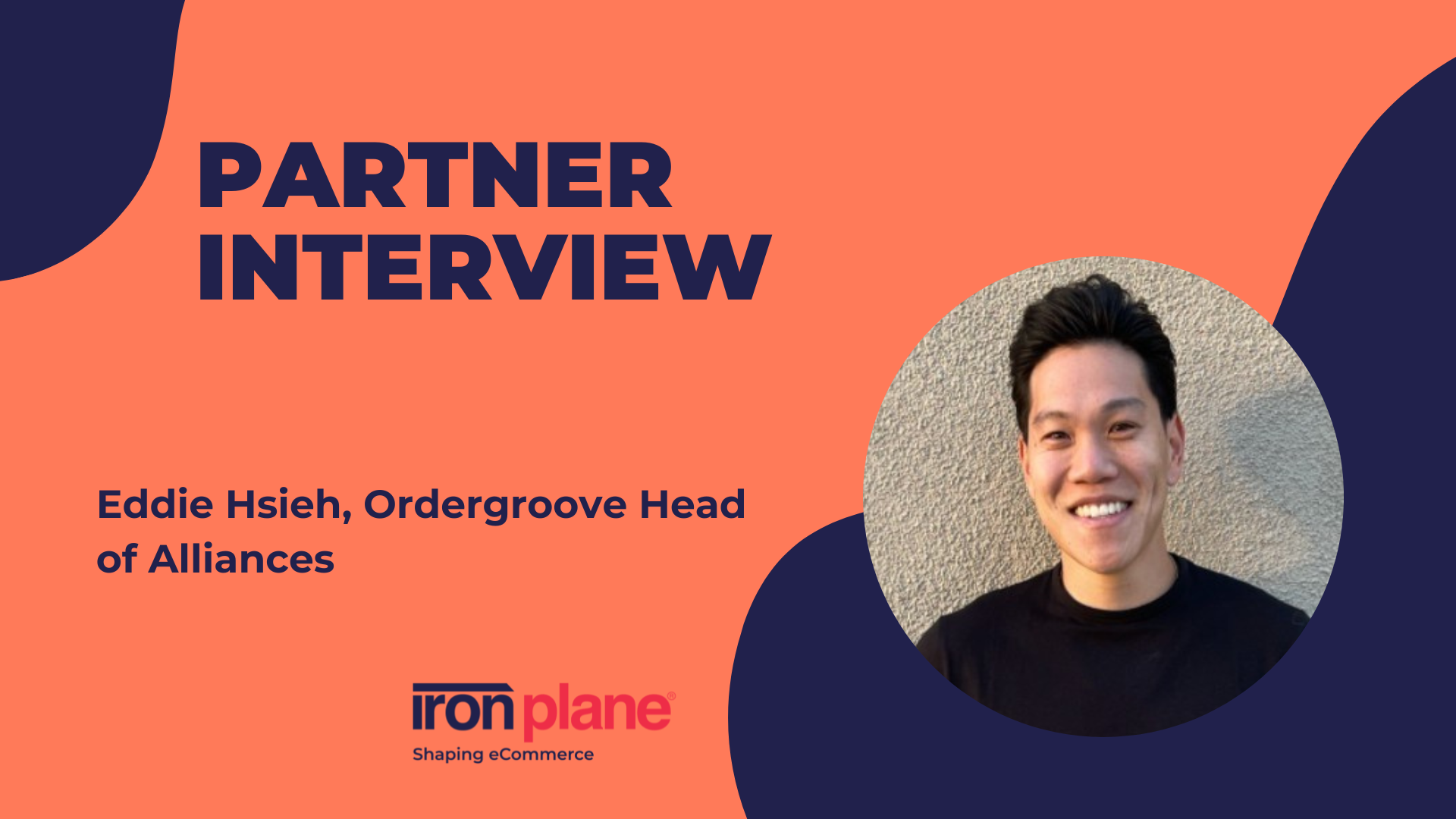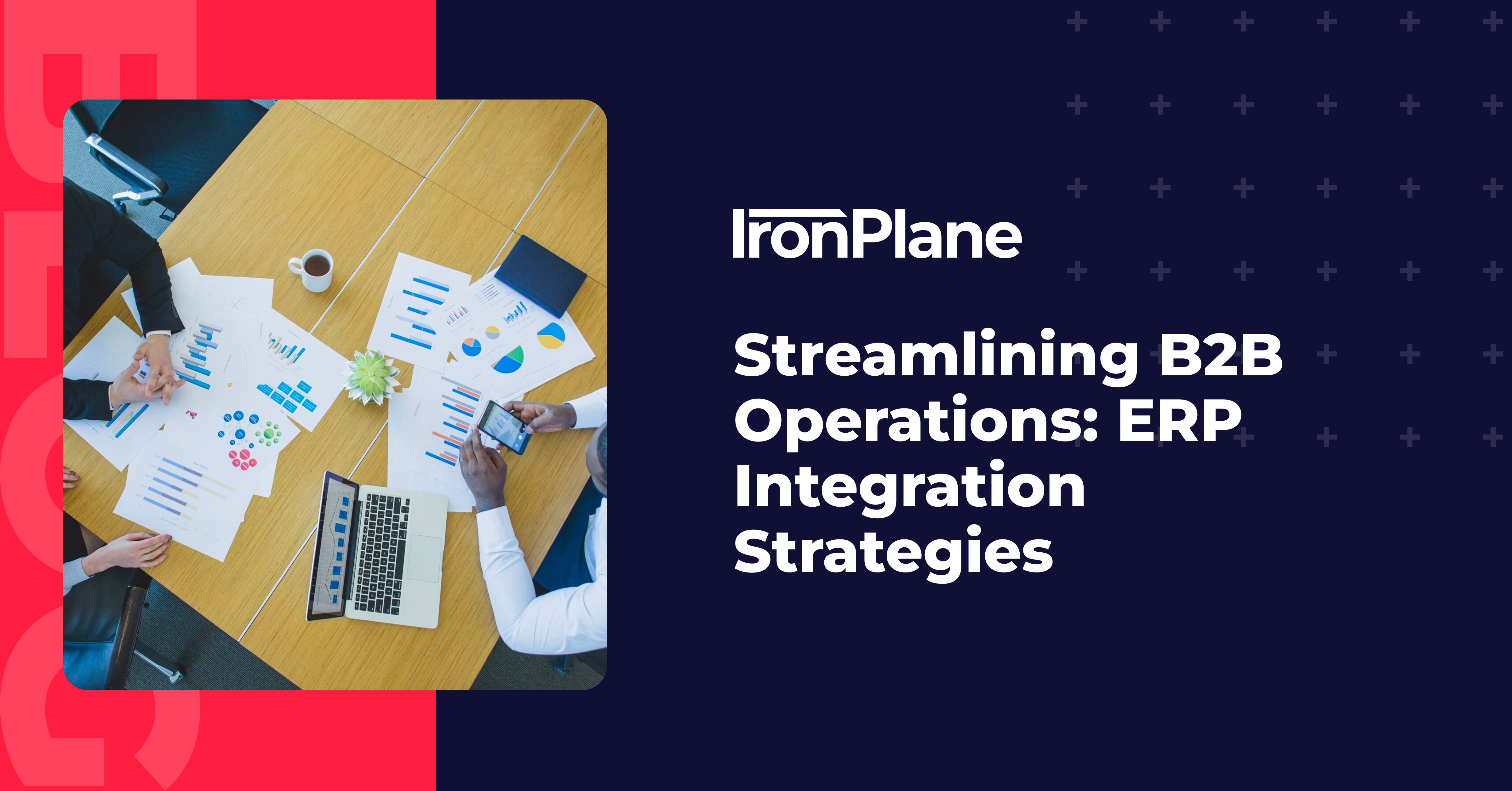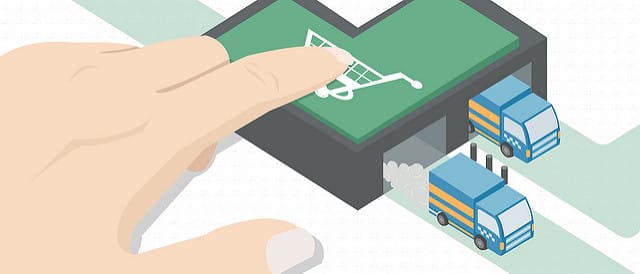Shaping eCommerce with Gaia Vernaglione, Director of Business Development (US, CAN, LATAM) at Zakeke
This interview discusses what Zakeke is, its ICP, and how 3D, AR, and VR, are crucial elements of an eCommerce foundation to stand the test of time.
14 min read
 Tim Bucciarelli
:
October 18, 2022
Tim Bucciarelli
:
October 18, 2022

Tim Bucciarelli:
Thanks everyone for joining us today on this episode of Shaping eCommerce with IronPlane. I'm Tim Bucciarelli, and today, I'm joined by Eddie Hsieh from Ordergroove. We're discussing subscription, subscription management, and the Ordergroove platform. So, Eddie, thank you very much for joining me today. And if you could give everyone a short intro about your background in your role at Ordergroove, that'd be great.
Eddie Hsieh:
Yes. Absolutely. Thank you for having me, Tim. This is super fun, and can't wait to dig into subscriptions. So my name is Eddie Hsieh. I'm the Head of Partnerships here at Ordergroove. I manage all of our external relationships between platforms, agencies, and technology partners. I've been here just shy of about a year and a half and previously spent four years on the partnership team at Shopify Plus.
And then before that, I worked at a Commerce Digital Agency called Retention Commerce. So probably seven or eight years now within eCommerce, kind of a breadth of experience between agency to platform.
Tim Bucciarelli:
That sounds like a perfect lead up to Ordergroove. You got the retention background, you got the eCommerce background. And give us a little bit of a snapshot in terms of Ordergroove specifically and its history or background. Where did it come from, and who's behind it?
Eddie Hsieh:
So we've been around for about over a decade now, so I'll try to keep it short. But Ordergroove is a relationship commerce platform focused on recurring revenue and subscriptions. We started out very, very early about, like I mentioned, just over ten years ago, powering the subscription programs for large retail brands such as Home Depot, L'Oreal, Estee Lauder, and so forth.
So back then, it was like half professional services where we'd actually build this out on custom platforms. And the other half was actually a SaaS business. As eCommerce evolved, like we know we've seen it does, from Demandware to the Magento days and now Magento and Shopify and BigCommerce, all these different platforms have a very predictable state for us to integrate with them to provide subscriptions.
So we're always natively integrated with the eCommerce platform themselves, and we provide a world-class ability to provide your customers with subscription management. So as an agency, we can work with our clients who are on the Magento platform to hook them into the Ordergroove subscription platform.
Tim Bucciarelli:
At that point, Ordergroove is essentially a SaaS platform that you're connecting with?
Eddie Hsieh:
Yeah, that's correct. So pretty much, we will be a frontend, usually JavaScript injection on the PDP, and then you'll give obviously a certain number of products or SKUs the ability to replenish at certain cadences.
We absorb all that data from the eCommerce platform, and then on the back end, when those cadences hit, usually a 30-day cadence for, let's say, skincare or protein powder, we'll actually inject those orders back into the platform, so the merchants themselves, or these brands don't have to worry or think about it.
Tim Bucciarelli:
Could you just give a quick snapshot of the history of Subscribe Pro? How did it start?
Eddie Hsieh:
So we're going back to nine years ago, our founder, a guy by the name of Garth Brantley, who's still our CEO and is still my boss. He had a development agency, and he realized that there was kind of a niche there that could be filled. At the time, most of his work was on Magento, which historically has been our bread-and-butter platform.
We work on other platforms now, but Magento is still probably number one for us, and he was like, I think that I can build a solution on Magento that kind of addresses some things that other solutions don't. And he set out to do that.
The company was founded in late 2013 and really started to take on clients in 2014. And like I said, I came on board five years ago in 2017 to continue the company's growth. But yeah, it came out of a development agency being like, Hey, I think there is an opportunity here. And then it was good enough that it was just like, Why don't we just do this instead of being a dev agency? Because we feel like this solution really has legs.
Tim Bucciarelli:
When you talk about clients, who do you describe as your kind of target client, and maybe then highlight a couple of clients that you work with today that are particularly interesting?
Eddie Hsieh:
Yeah, absolutely. It's definitely evolved over the course of the last ten years. So primarily, if you looked at us when we first started, it was a very enterprise-heavy tool.
We had an incredible sales team, which we still do, selling into the IR one thousands, to top retailers in the world and trying to provide an online subscription experience for them and also Omnichannel. So we're actually in many retail locations at the POS level. As these SaaS eCommerce platforms start to come out, maybe Demandware.
We're very tightly integrated with them later on. We would target the mid-market a little bit more. Obviously, with the more recent wave, perhaps in the last five years of these fast-growing D2C brands, we've been integrating with BigCommerce and Shopify and allowing these fast-growing brands to actually scale for subscriptions.
So if you look at our ICP, it's kind of pretty much everything right now. We have a lot of experience. So when we have our large retailers, we still power the subscription experience for L'Oreal, PetSmart, Home Depot, The Honest Company on Salesforce Commerce Cloud.
When you talk about the high growing mid-market segment and the D2C brands, we have Stumptown Coffee, we have Peet's Coffee, we have Birchbox, which is like a poster child of subscription boxes, and Shinesty, which is like a really fun boxer underwear company. So we're continuing to serve the VSPs, and having this really product-led approach in the future is a huge priority for us.
Tim Bucciarelli:
For merchants who are looking for ideas about what subscription platforms would best suit their needs, you know, what features do you kind of highlight to those merchants that are a little bit more unique for Ordergroove?
Eddie Hsieh:
It definitely depends on the market segment that you're in. that might cater to specific merchants, whether they are 100% online, But one thing to really, really keep in mind is you would want to find a partner within the subscription space that's going to be very retail focused.
They need to be used to dealing with high SKU accounts and dealing with solid goods that have inventory.
When you look at this market within the subscription space and recurring revenue, you’re totally right. It's kind of all over the board, and there are a dozen competitors everywhere. But then you look at perhaps the Chargifys and Chargebees were incredibly powerful platforms, but that's something that I would use if I started a SaaS company these days, right?
If you look on their page, it's usually like really large SaaS companies that leverage them. So you want to make sure you're on a retail or a kind of brand-focused type subscription platform.
And then, within that space, you look at some of the competitors. One thing about subscriptions is obviously it deals with a lot of payments. So just because of security reasons and scalability reasons, you want to make sure that the partner that you're with can scale with you into the enterprise as you grow.
I think most, if not every single small business has the ambition to grow, you know, much further than they are right now, and hopefully double or triple revenue year over year for fast-growing D2C brands. So at some point, most platforms are going to hit a limitation on a lot of things that I mentioned, like out-of-stock management, a custom portal for your subscription management interface.
These are things Ordergroove has been doing for a decade. So it allows you to be incredibly flexible as you grow. So for us, some features that people really, really enjoy are out of the box for a customer portal or what we call the “subscription management interface” will give you the ability to provide your customers to skip a delivery, change the date of a delivery if they're overstocked or if they're on vacation.
If they get flavor fatigue for a coffee bean or protein powder, you can actually SKU swap without having to cancel the order if you want to. If you want to add a single SKU to your next subscription, you can do that on the same checkout and not be billed at a different cadence.
So all of these things that you’d maybe not thought about when you first set up subscriptions for, “I just want 30-day replenishment on two SKUs.” You'll soon bump up to these limitations. And we've seen pretty much everything in the last ten years. And we'd like to think that we can power merchants of all sizes and we’re incredibly platform-agnostic.
Tim Bucciarelli:
As an end user, I can tell you how much I appreciate that type of flexibility when I can go in and I can adjust all of my settings for whether I want to skip one or whether I don't want to do 30 days, I want to make it 60 days. And if I am away, but I don't want to miss a delivery while I'm on vacation, maybe I can put in a new address for that particular shipment just to temporarily get it there.
Eddie Hsieh:
Yes, and that’s one of the biggest reasons for cancelations. And on a lot of other platforms, you’ll have to do a lot of custom development and hacking around the eCommerce platform. For us, it’s out of the box.
Tim Bucciarelli:
At IronPlane, we work with two eCommerce platforms. We work with Magento, also called Adobe Commerce and we work with BigCommerce. Could you touch on kind of any of the experience that you have with Ordergroove in those particular platforms?
Eddie Hsieh:
We integrate with both of those very deeply. And when I mean deeply, it's at the checkout level. One thing is Ordergroove doesn't have the notion of our own checkout. You’re never exiting whatever commerce platform you’re on or the storefront experience to actually checkout for a subscription purchase. And that holds true for both BigCommerce and Magento.
Magento really is still the most flexible, obviously open-source platform available on the market. So we see very, very interesting use cases, usually build-a-box or curation boxes, where you're throwing items into a single subscription possible on Magento. So we have people like Hotel Chocolat in the UK, it's like the Godiva over there. It has very complex subscription logic, and we power that on Magento.
For BigCommerce, obviously more so in the SaaS platform where it's a little bit more closed source and you have to work within a limitation, but everything's a little bit more predictable, right?
You can't get out over your skis on a closed-source platform because they have built-in rails to keep you there. So we see a lot of the faster growing D2C brands, perhaps with a smaller B2B use case on BigCommerce.
And again, we're thoroughly and directly integrated with them and allowing them to scale. We also power almost every single Procter and Gamble brand for subscriptions on BigCommerce. So if you look at Gillette, Art of Shaving, and Olay, that all have Ordergroove tied into the PDP. So both eCommerce platforms are great. I think it depends on where you are as a merchant, how much international you do, how much B2B you do, and how many storefronts you want to carry, that will actually allow you to make the right decision.
But we've seen them all.
Tim Bucciarelli:
As a merchant, I would be a little anxious about undertaking a subscription platform for my business if I feel like it's going to be a little bit more complicated. Does Ordergroove have a spectrum of what you offer?
Eddie Hsieh:
I would say we would fit somewhere within that spectrum. “We have open APIs, do whatever you want, if you want to,” all the way distilled down to, “Hey, our new BigCommerce project actually does have this self-service side of things.” “We can go into the App Store, you could download, you could pick the SKU, and you can set subscriptions up.”
And that's a muscle, candidly, that we haven't had in the past because we've been so enterprise-heavy. So for our entire company to say, “Hey, let's start serving this part of the market and do it really well,” is super special.
And something about Ordergroove is like we're trying to go deep in everything that we do. So we want to make sure the experience is actually, we think about the totality of the experience to make sure that the download, the install, and the configure stage is all very easy.
And then when you need a little bit more of complexity, they should be talking to people like IronPlane to see, “Hey, what are the limitations of the platform?” “How creative can I get with subscriptions?” “How do I drive the LTV up for each one of my subscribers?”
So it's very exciting. But we're starting to serve the spectrum, the lower end of the spectrum, which is the fast-growing D2C brands like we haven't before.
Tim Bucciarelli:
With Magento, is there an extension that exists that either was developed by either Ordergroove directly or from an existing Magento development company?
Eddie Hsieh:
Yes, Ordergroove is available for 2.3 and, most recently 2.4, and those are both available, and we have dozens of merchants on each of those integrations.
We product managed the entire 2.3, and then it was built externally. 2.4 we brought in-house.
Tim Bucciarelli:
Great. So I understand that Ordergroove has some facet of its functionality built-in, like the AI realm, AI, and machine learning. And the push for authentic customer engagement these days is very real from both sides. Both merchants want it, and the customers want it. So, where does AI play a role for Ordergroove?
Eddie Hsieh:
We at Ordergroove are going to talk about AI from the subscription standpoint. So we have something called Anticipate AI, which is really a machine learning engine where we're ingesting data from how the customers interact with the subscription management interface, the emails that you send out in perhaps their last order history or status, and we get that data and hopefully spin it to you to provide a more authentic and more human experience.
So for us, it's called Anticipate AI. We will actually put “Hey, because they've been poking around the SMI, “because they're skipping certain deliveries, they might be overstocked.” So we actually put a churn score on them, right?
So it's a very real-life example of how AI can work for you as a brand. You can take that churn score, integrate it with your ESP, and from different tiers, depending on the churn score, you can send different messaging. And we found out it's actually very good to be incredibly proactive about people who might be canceling soon because it's always better for them to skip one, two, or even three orders and extend the LTV and make sure that they stay on as subscribers.
Then the next order shows up on the doorstep. They look at the credit card statement, and they’re like “Oh man, another 50 bucks I didn't expect,” and then they go cancel the order. So everything, all the tools that we provide are for you as a brand to provide a more authentic experience.
We don't take over any verbiage or language, like “You should be saying this”, but we do provide a lot of information for you to take the next step.
Tim Bucciarelli:
Right. So another element that I see frequently is this kind of the sense of quizzing people as they're thinking about canceling a subscription. What is the role that type of interaction plays?
Eddie Hsieh:
I think anything with forms in a guided selling experience with zero-party data is really important right now.
Like you just mentioned, the more data you have, the more empowered you are as a merchant, the better you are in the future, right? So for us, we actually have very advanced tools and we integrate with other partners that when people do cancel from your service or cancel from your product, there's like a set of questions on why they cancel, right?
You can absorb that into your CRM. Is it because they don't like the flavor? Is it because your supply was too low? You provide three fluid ounces of face cream and it should really be six, and then you can actually go and make the product better and then retarget or reach out to canceled subscribers in the future.
So the ingestion of zero-party data right now through forms and quizzes, even at a cancelation level, is super important. On the flip side, the guided selling experience for you as a merchant, again, we want to provide this authentic experience. You want to build that community and that relationship, to have it on the front end, to say, “Hey, what's your skin type?” “Do you use sunscreen?”
Or whatever it may be, you have this entire experience to target the number of SKUs that you think would be best for them to obviously improve conversion and hopefully turn them into a subscriber. So forms in general, guided selling, zero party data. I think it's only going to get more popular and a lot of merchants are leveraging it in really cool ways.
Tim Bucciarelli:
Related to zero party data, I'm thinking mainly about the kind of initial questionnaire to get the kind of “get to know me” questionnaire I can see that is interesting in two realms. One is the privacy realm.
As a user, you want to make sure that your information isn't being kind of, you know, I don't know, advertised anywhere else or shared with any other companies. I know that that's down to the merchant, not Ordergroove. But regardless, making use of that data throughout that customer's experience could be interesting. Is that something that's built into Ordergroove or is that something that's a little bit more sophisticated?
Eddie Hsieh:
I think it's going to be more at a marketing automation SaaS CDP level. What we want to do is take every single subscription order, and make sure that you can actually build in fields, metadata, and things to actually spit back into it. I do think personalization in general is things that people are underutilizing.
So if you see some of those awesome platforms out there, definitely take a demo and see how you can enhance the experience. But for us, it's really just subscriber data and subscriber information. Give it back to the marketing automation tools and then hopefully you can work your magic there.
But really segmentation and cohort analysis right now is huge, especially as you're trying to mine within your customer base to see how you can generate more lifetime value.
Tim Bucciarelli:
What if, as a purchaser of a subscription, I want to manage my subscription? Is that something that I do within Magento, or do I go to a different portal?
Eddie Hsieh:
You would still do that within my account page on the vendor’s site. So again, an end user should never be directed away from the Magento site. Subscribe Pro adds my subscription section to the accounts page within Magento. So you're still on the Magento site, you still see everything matches the theme of the site, and that gives the subscriber the ability to push my next order off by a week or two or skip my next order or pause for now, or update my address because I just moved, or change the card that I'm using to pay for it.
All of that is available on my accounts page on the merchant's site speaking to the subscriber. And the URLs all stay the same, so nobody gets freaked out by being pushed to a different URL for a different company that they've never heard of.
Tim Bucciarelli:
Wonderful. So you’ve given me a sense of the history of Ordergroove, their place in the market, their kind of unique offerings, their integrations, and the broad spectrum of available functionality. Are there any misconceptions out there that you've come across in the subscription world, whether it's by merchants or by end users in terms of subscription platforms in general?
Eddie Hsieh:
I wouldn't say misconception, but I would say kind of the entire ethos from the consumer side of things, is like, “Ugh, I don't want to subscribe to more things because obviously I'll forget and things will keep coming in.”
So as a merchant, I think the biggest thing to do to combat that is to actually provide a world-class subscription experience. And usually, the misconception is that all subscription platforms are built the same.
It's like, “Hey, I'm just going to set these SKUs for 30-day replenishment, put it on my PDP, and hope it works.” The level of features and the depth of features that these platforms will vary greatly, right? And especially everything going on with kind of the top of the funnel and marketing dollars.
And like you mentioned, Apple app tracking and everything, that top funnel is going to be very, very difficult to keep mining. So going into a subscription platform, try to map out what you expect today, what your subscription program looks like, and poke around and see how what type of merchants are doing something that's very creative perhaps something you would maybe do two or three years down the road.
And from there I would make actually a choice that you can scale into because with subscriptions and payments, the last thing you want to do is do a large migration with thousands of payment tokens and you never know the level of risk to your business that has. So don't pick something that's just fit for today.
Pick something where you want your business and your subscription program to be in three years. Find the right partner and go from there.
Tim Bucciarelli:
And that's exactly the point of these conversations we're having. It's really important that we educate ourselves as an agency, as an eCommerce agency, to learn more and more about these platforms so that we can advise our clients, or at least not even advise them, but just put in front of them the best in class platforms that we've discovered so that they can then evaluate based on their needs and take the time to fully think out their needs and find exactly the right platform.
So that's totally in line with what we're doing these days. And hopefully, merchants out there will take advantage of this conversation and other conversations and learn as much as they can before they sign up with a platform that may not quite meet their needs.
So with that in mind, can you give folks some idea of maybe your recommended first steps for them if they're looking at Ordergroove?
Eddie Hsieh:
I think a great place to start is ordergroove.com because we actually did a rebrand about six weeks ago. So you're going to have a lot more case studies, and you're going to have several different contact forms.
We are powering some of the largest subscription programs in the world for both retailers and D2C, so to learn something from them would be awesome. So visit our website, and feel free to reach out.
Tim Bucciarelli:
Well, Eddie, thank you so much for joining us today on “Shaping eCommerce” and I’ll look forward to maybe having another session where we dig a little bit deeper into subscriptions. But for now, hopefully, our audience has learned a little bit more, and thank you very much for joining us.
For more insights on how to improve your eCommerce website, and for a free consultation, visit www.ironplane.com, follow us on LinkedIn, and subscribe to our YouTube channel.

This interview discusses what Zakeke is, its ICP, and how 3D, AR, and VR, are crucial elements of an eCommerce foundation to stand the test of time.

ERP integration is important for B2B companies that want to improve how they manage orders. It connects different business systems and puts all the data in one place.

Find out the Ways to Automate Account and Order Management to improve your tracking.